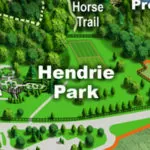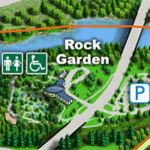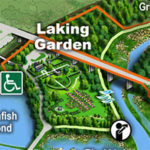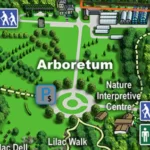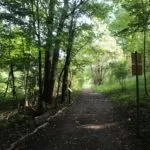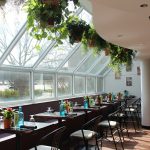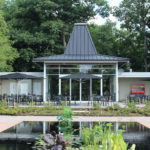| Membership | Price (+HST) |
|---|---|
| Single | $85/year |
| Single Plus | $120/year |
| Family | $130/year |
| Family Plus | $175/year |
| Contributing | $300/year |
| Supporting | $600/year |
| Sustaining | $1,000/year |
| Benefactor's Circle | $2,500/year |
| Director's Circle | $5,000/year |
| President's Circle | $10,000/year |
Laking Garden
Set on a fertile terraced plain that was once a market garden, Laking Garden is home to RBG’s herbaceous perennial collections. The belvedere at the end of the entrance path offers a panoramic view of the entire garden, especially spectacular in early to mid-June when our iris and peony collections shine. Take time to explore how early Ontario gardens mixed edible, medicinal and ornamental plants in the Heritage Garden.
Key Attractions
- Iris and Peony Collections (June)
- Gazebo and Pergola Lookouts
- Clematis Tree Sculptures
- Barbara Laking Memorial Heritage Garden
Garden Facts
- Over 1.7 hectares (4 acres)
- Showcases 2,447 types and 62,463 individual plants
- Opened in 1947
Visiting Laking Garden
Admission
- Garden Admission applies. Single Garden admission available, or purchase Full Garden Admission for access to all open RBG garden areas.
- FREE for RBG Members
Parking
Pay and Display parking is in effect, $3/hr to a maximum of $15. Parking is FREE to RBG members with a RBG parking pass.
Getting to Laking Garden
1221 Spring Gardens Road, Burlington, L7T 1J8
Laking Garden Hours
Hours reflect garden admission availability at Laking Garden, and may differ by garden area. Ticketed events and programming may fall outside these hours.
Today’s Hours
Seasonal Hours
- Temporarily Closed (Jan 1 to Apr 30)
A New Chapter for Laking Garden’s Signature Collections
Laking Garden is home to one of Canada’s most significant collections of perennial plants, including irises, peonies, and other cherished blooms.
In 2025, we’re beginning the thoughtful relocation of part of the renowned Iris and perennial collections from their longtime home in Laking Garden to an optimized new setting in Hendrie Park. These signature plants will flourish in an environment that promotes their long-term vitality, public enjoyment, and education.
Grounded in detailed research and careful planning, this transition is guided by our commitment to plant health, sustainability, and the visitor experience. Extensive preparation is underway to ensure a smooth and successful move, while elements of the Peony Collection are being considered for a future phase.
This marks the beginning of an exciting transformation for both the collections and the gardens themselves, with further updates to come as we shape the next chapter of this beloved garden space.
Help Create Gardens that Inspire, Educate, and Flourish
We’re embarking on an exciting transformation—and we need your help to make it happen.
Why Your Gift Matters:
- Your donation helps create world-class gardens that inspire and educate.
- It supports conservation efforts and the preservation of rare plants.
- Your generosity ensures RBG remains a sanctuary for nature, health, and community.
Collections & Areas of Interest

- Iris Collection
- Tree Peony Collection
- Herbaceous Peony Collection
- Barbara Laking Memorial Heritage Garden
- Ornamental Grasses and Monocots
- Hosta Walk
- Perennial Borders
- Clematis Collection
Iris Collection
Peak Interest: June
The iris collection was RBG’s first herbaceous collection of importance. First plantings in 1947 focused on tall bearded iris. The name Iris derives from Greek meaning rainbow, referring to the wide variety of flower colours found among the many species and cultivars. Our collection includes award-winning bearded iris and hundreds of others including miniature bearded, dwarf bearded, intermediate bearded, border bearded, tall bearded, Siberian, spuria and wild species iris.
Peony Collection
Peak interest: June
RBG’s peony collection displays herbaceous and Itoh peonies displayed on the lower terrace of the Laking Garden and tree peonies located in the beds adjacent to and opposite the Laking Garden entrance Kiosk. The tree and Itoh peonies form a modest subset of the collection with main emphasis being given to herbaceous peonies which feature, single, Japanese, anemone, semi-double, bomb and double flower types. The collection has been laid out not only to display flower diversity but also to represent the colour diversity of cultivated peonies. The peony collection has been in existence at the Laking Garden since the mid 1940’s and is one of RBG’s signature collections. Given its age and history, the collection displays a high diversity of cultivars and hybridizer introductions from the nineteenth, twentieth and twenty first centuries. As a result, the collection interprets generational breeding trends and is one of the most diverse and unique peony collections in North America.
Barbara Laking Memorial Heritage Garden
Peak interest: April to August
Rejuvenated in 2009, the Heritage Garden includes many cultivars and species commonly grown in an Ontario garden between 1880 and 1920.
The garden features a ‘plants of necessity’ area with heritage vegetables, herbs and fruits. It illustrates the importance of plants for food and medicine for newly settled Europeans’ survival. As such, this area of the garden relates to human well-being, sustainability and resilience in the face of tough living conditions.
The ‘garden of luxury’ represents a societal transition from gardens of subsistence and self-reliance to those of luxury, leisure time and ornamental beauty. Such garden history provides an interesting insight into period living, societal values, economics, trade and even politics. Included here is heritage plant material acquired from ghost towns of southern Ontario and collected by RBG’s taxonomist, Dr. Jim Pringle.
In essence, the Barbara Laking Memorial Heritage Garden is a seed and gene bank conserving those plants that have practical and beneficial traits within their gene pool. Many of our older or heritage cultivated plant are the seed or pollen parents of modern varieties and retain desirable characteristics such as pest and disease resistance, hardiness to a variety of climates, provide food for pollinators, the ability to remove pollution, and provide us with pharmaceuticals. It is essential to conserve these desirable traits for future plant breeding and our food security. The more we conserve within the gene pool now, the more plant diversity we can ensure for future human prosperity.
The Heritage Garden is dedicated to Barbara Tarver Laking (1915-1986). Raised in England, she brought her life-long dedication to horticulture to Royal Botanical Gardens, originating our decorative arts program and co-founding the RBG Auxiliary. With her husband, former RBG director, Dr. Leslie Laking, Barbara grew and made available, uncommon plants that are now favourites in many Canadian gardens.
Hosta Walk
Peak interest: May to August
Illustrating the diversity of the genus, this collection displays species Hosta, classic cultivars and new introductions. In the 1970’s there were but a few hundred species and cultivars but with their increasing popularity there are over 7000 today! Due to this surge in popularity, Hostas are a foundation plant in many perennial gardens and especially useful as a ground cover. While primarily grown for their leaves, many have beautiful and fragrant blossoms. In the past ten years some hybridizers have actually made flower production and performance the primary focus of their attention. Hostas show great diversity in their leaf size and shape with green, blue-green, white and gold often represented as foliage colour. Hostas are shade-loving perennials demonstrating that it’s easier than you think to garden in the shade.
Hostas provide a good example of how the science of botany is an ever-evolving discipline. Hostas were once classified within the Liliaceace or lily family. With the advent of genetics as a science, many plants are being reclassified into new families as new genetic information clarifies evolutionary relationships within the plant kingdom. Today, Hostas are in the Asparagaceae family.
This collection was developed with the help of the Ontario Hosta Society.
Perennial Borders
Peak interest: April to August
Perennials are becoming a more sustainable choice for home gardeners who find the yearly planting of annuals onerous and costly. Laking Garden displays a wide range of hardy herbaceous perennials where the visitor can observe their vast diversity of form, texture, colour and season of bloom.
The middle terrace perennial collection is divided into three areas: traditional English style borders, free form (island) beds highlighting the very latest in new perennial introductions, and European style beds designed with ecology and low maintenance in mind. The plants in these beds are chosen for their ease of care, strong structure and longevity creating sustainable perennial beds.
Clematis Collection
Peak interest: June to August
Clematis is a highly collectable genera of herbaceous perennials and climbing vines. There are more than 4000 species, cultivars and hybrids in existence. Flowers large and small, sprays of star-like flowers, hanging trumpet shaped flowers and a bountiful array of colour combinations; Clematis come in a stunning variety of forms that are sure to pique your interest. Even the fluffy and feathery seed heads are magnificent well into autumn.
There is a long history of collecting Clematis at RBG, going back to 1986 with the opening of the Ann Harvey Clematis Garden in Hendrie Park. This Clematis Collection was re-imagined and included during the renovation of the Laking Garden which re-opened in 2014. The iron ‘tree structures’ were designed by the award-winning Virginia Burt Designs (www.vburtdesigns.com) and fabricated by Dan Klick, both from Burlington, ON. These iron tree structures provide support as trellis’ for the twining vines to climb.
This Clematis Collection was created to feature a sampling of the diversity of Clematis with a variety of flower types and colours. It features historical cultivars developed as far back as 1623 (‘Polish Spirit’), the late nineteenth century (‘Candida’ – 1862 & ‘Duchess of Albany’ – 1890), throughout the twentieth century (‘Blue Belle’ – 1923, ‘Margaret Hunt’ – 1969, ‘Mrs. Harvey’ – 1999) and the twenty-first century with newer hybrids added regularly. The Clematis Collections also features cultivars which were hybridized throughout the world, notably in Poland, France, Japan and United Kingdom and features some prominent hybridizers in the world of Clematis (Raymond Evison). There are approximately 30 taxa (different types) of Clematis displayed on the Lower Terrace of Laking Garden near the Gazebo.
What’s in Bloom & Plants of Interest at Laking Garden
Note: Bloom times can vary from year to year as they are influenced by many natural events including temperature and climate. Please bear in mind an early or late spring can drastically shift bloom times.
April
- Spring Ephemerals
- Iris reticulata
May
- Flowering Cherry*
- Magnolia*
- Iris
- Clematis
- Coral Bells
- Hosta
- Tree Peonies*
*These plants have short bloom times and are very weather dependent. Check our social media feeds closer to bloom time for updates.
June
- Iris*
- Peony*
- Day Lily
- Clematis
- Coral Bells
- Hosta
- Sunflower Family
- Grasses
July
- Day Lily
- Clematis
- Coral Bells
- Hosta
- Sunflower Family
- Grasses
- Vegetable Gardens
August
- Clematis
- Coral Bells
- Hosta
- Sunflower Family
- Grasses
- Vegetable Gardens
- Korean Evodia
*These plants have short bloom times and are very weather dependent. Check our social media feeds closer to bloom time for updates.
History of Laking Garden
The second-oldest garden at RBG, this site was once an orchard (some of the apple trees and cherries still remain) and market garden, with a small cottage on site. It opened in 1953 with perennials and bulbs displayed in large island beds, an innovation of the 1960’s; at this time, it was known as the Spring Garden.
In 1948, the original Iris collection was formed and planted into the Spring Garden. Part of the original Iris collection was donated by W.J. Moffat, founder of the Canadian Iris Society. This was the first featured plant collection at RBG.
In 1981, the garden was re-named after Dr. Leslie Laking, RBG’s longest serving Director and Director Emeritus, upon his retirement. The Barbara Laking Heritage Garden commemorates his wife, who founded our Auxiliary.
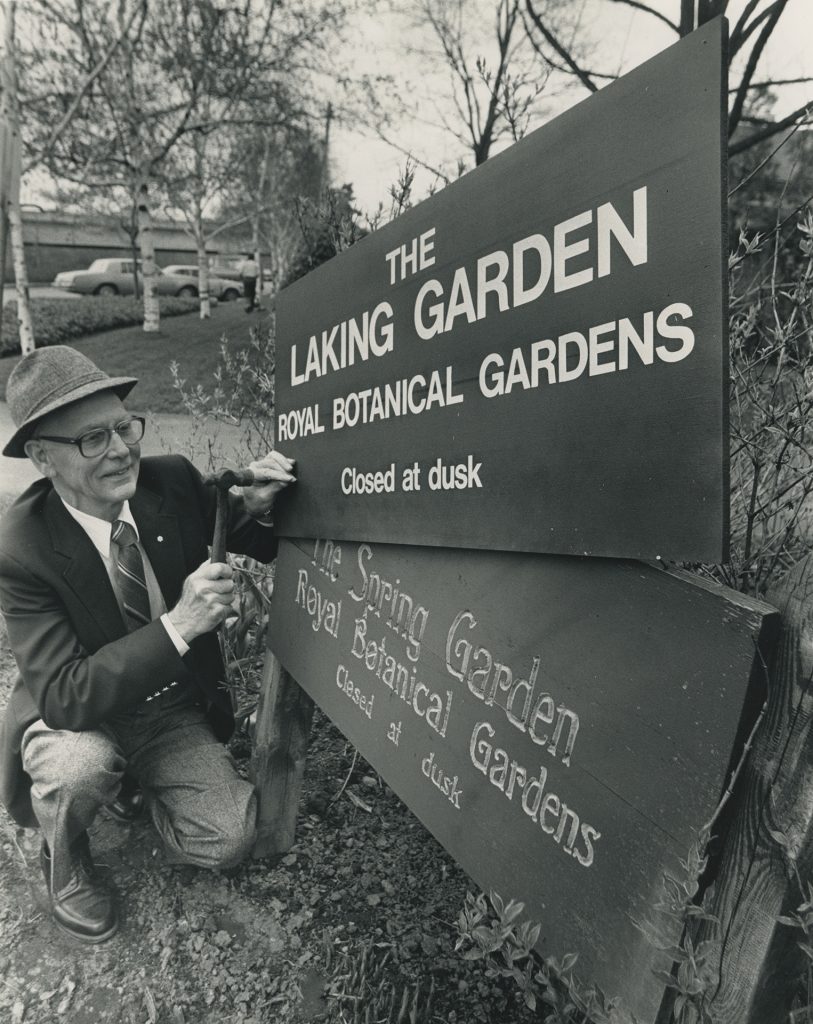
Garden FAQ
Directions / Parking
Parking available in the upper parking lot (off Plains Rd. W.) or in the lower lot (Spring Gardens Rd.). NOTE though finding the upper lot is easier for those on their first visit, accessing the garden from this lot requires walking across a bridge and descending down a winding ramp. For those with accessibility concerns, we recommend using the lower parking lot.
Before departing, have a close look at a map of the area to familiarize yourself with the route; Spring Gardens Rd. (and the two parking lots) is bisected by a train track, and is NOT a through road.
Pay and Display parking is in effect at Laking Garden ($3/hr to a maximum of $15), or free with a Member parking pass.
Admission
Access to Laking Garden during regular operating hours is included in your Garden Admission or with your Membership.
Garden Admission includes access to all the cultivated garden areas for the day, including: Hendrie Park, RBG Centre, Laking Garden, and the Rock Garden.
$10 ‘Single Garden’ admission available. This provides access only to RBG’s Laking Garden and does not include access to all other RBG’s cultivated garden areas. Available for purchase in-person.
Special events or exhibits require separate tickets.
How Far is Laking Garden from RBG’s Other Garden Areas?
- Laking Garden to RBG Centre / Hendrie Park: 1 km / 0.6 miles
- Hendrie Park to Rock Garden: 1 km / 0.6 miles
- Hendrie Park to the Arboretum: 2.2 km / 1.4 miles (walking not recommended. Old Guelph Road does not include sidewalks
Walking from garden to garden is possible, but please be aware that our property is spread out over 1,100 hectares of gardens and nature sanctuaries. Please consider driving or biking between locations, or using the shuttle service when available (weekends, spring to mid-summer).
Are there Washroom Facilities Available?
Small washrooms are available just outside the garden gates (see map for location) available during Laking Garden’s operating hours.
Are there water fountains / bottle refilling stations available?
Water Fountains and bottle filling stations are available at all RBG garden areas.
At Laking Garden, outdoor bottle refill station available by the washrooms.
Food and Drink / Picnics
Pack a picnic! Outside food is permitted at Laking Garden (excluding special events). Please pack-out or properly dispose of any waste. Outdoor cooking is not permitted in any of RBG’s garden areas.
Laking Garden has a limited number of picnic tables. Enjoy your meal on one of the garden’s many benches or bring your own blanket for a picnic!
Outside food is not permitted at RBG Centre, Hendrie Park, or Rock Garden. Outside food is only permitted at Laking Garden and the Arboretum (excluding special events).
Is the Garden Accessible?
All garden paths indicated on the garden map are either paved, or made of finely packed gravel, suitable for wheelchairs and walkers meant for outdoor use.
Laking Garden includes three terraced levels. The primary path to the lower two terraces (including the largest section of the garden) includes two sets of stairs. An alternative, sloped path is available alongside the South-West border of the garden, though this slope may prove too steep for some patrons. Instead, enjoy the garden view from the newly rejuvenated pergola, just inside the garden gate.
Can I Bring My Dog?
Leashed dogs are permitted in the gardens for a visit during regular operating hours. Please be responsible and clean up after your dog.
Some special events at this location may not accommodate dogs. These are noted in the individual event FAQ’s available on the event pages.

